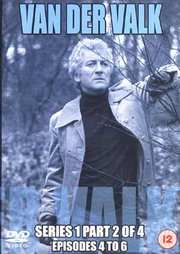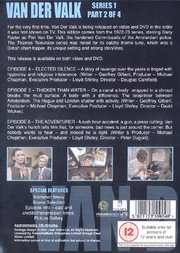Review of Van Der Valk: Series 1 Part 2 Of 4
Introduction
Nicholas Freeling`s series of detective novels featuring Amsterdam-based sleuth Van Der Valk were brought to the screen by Thames Television in 1972. The series is probably best remembered for Jack Trombey`s theme music "Eye Level" which provided the Simon Park Orchestra with a four-week number one hit in September 1973.
Van Der Valk is a typical tv rozzer of the early 1970`s, a hard-drinking, chain-smoking don`t-muck-me-about-son police officer whose private life tended to get in the way of his sleuthing. In temperament, he has a lot in common with John Thaw`s Jack Regan in "The Sweeney" (1975), but as the show predated even the "Sweeney" pilot by two years it lacks any of the cheerful kick-`em-in-the-teeth brutality of Regan and Carter`s adventures.
Disc Two features the episodes "Elected Silence", "Thicker Than Water" and "The Adventurer".
It should be noted that while ClearVision have labelled this four-disc set as "series one", tv historian Dave Rogers lists the episodes on these discs as series one *and* two. The first six episodes are series one (1972) and the second series (1973) comprises the remaining seven. A third series was made in 1977.
Video
The first two seasons, made in 1972 and 1973, were produced on studio videotape and location film, which makes for a jarring change in image quality between formats. Curiously, the videotape interiors suffer more from artefacts than the location shots. This was not a problem for the third season (1977), which was made on film by Thames` offshoot responsible for "The Sweeney" and "Minder", Euston Films.
Technically, these transfers are of acceptable quality. The source material is not in the best state it might be in due to its age (and the fact it is on videotape). This means focus is soft, contrast is high and highlights tend to flare badly. Curiously there seems to be more grain in the videotape sections (which should have no "noise" in them) than the filmed location material. As with the "Minder" releases, Fremantle have chosen to licence the material to Clear Vision, whose own logo on the disc shows an alarming level of compression artefacting that does not carry through to the programme material, fortunately.
Audio
Sound on the discs is only mono, as you would expect from a tv show of this era.
Features
Extras are minimal, with no HOH subtitles, short textual episode descriptions. The "photo gallery" consists of six freeze-frames from the episodes on the disc and there`s a static menuing system.
Conclusion
When you watch a show of this vintage - specifically a videotaped show (as opposed to filmed), you realise that "early" tv drama was made in a completely different frame of mind to its filmed equivalent. Even the actors behaved differently on VT. There are more meaningful pauses, shifty looks and stilted lines than you`d find in the nearest filmed equivalent. I`d call it the Dr Who school of acting. Try watching an ITC show like "The Persuaders" or "Randall and Hopkirk" after watching Van Der Valk and see which has dated better in comparison with modern tv shows. I think the bottom line is there is a sense of artificiality about taped shows of this era that sets them apart.It most likely had something to do with the completely different way shows produced on tape were made compared to filmed shows. Studio-bound productions of this time were videotaped with as little physical editing as possible, using multi-camera setups and carefully rehearsed camera switching to achieve the same effect as filming scenes with different camera set-ups and then editing the material together. Lighting had to be set up to suit two-to-three cameras rather than a single film camera, and material was recorded in longer blocks than shooting single scenes or parts of scenes. Camera movements were also problematic, the cameras weren`t today`s lightweight, handheld or steadicam devices but those enormous Emiscan colour monsters on Vinten gas-lift pedestals that were about as manoeuvrable as your average Dalek.
There`s little action in these shows (what there is takes place on filmed locations), but there is a lot of talking. It will be interesting to compare the 1977 episodes (made by Euston Films) to see if the different production techniques affected the style of the show.


































Your Opinions and Comments
Be the first to post a comment!